Having the sound on your Mac not work can be frustrating, and understandably so—not to mention if it happens during a work or school presentation.
It could come down to a host of factors, like your Mac’s sound being muted or your MacBook speakers crackling. Whatever the case is, it doesn’t necessarily mean that your Mac is broken.
So, don’t rush to call Apple Support just yet—there are a few things to check before taking your device to the nearest Apple store. Our article will outline all the steps you need to take to find and fix the volume error on a Mac device.
Before we start:
The sound not working on your Mac can be a consequence of multiple system problems. This is why it's necessary to keep your Mac in good condition as this will minimize any risks: check it for viruses and malware, optimize its performance, and clean it systematically.
If you ever get stuck trying to troubleshoot sound issues like QuickTime not recording sound on your Mac, it may be helpful to rope in a professional. MacKeeper’s Premium Services connects you to experienced tech experts who can assist you in resolving the sound issues, saving you time, helping you avoid making costly mistakes, and allowing your Mac to run smoothly.
Take the following approach to using MacKeeper’s Premium Services:
- Download and open MacKeeper and choose the Premium Services option from the sidebar.
- Use the chat function on the right to describe your issue. We’ll assign a dedicated tech expert to help you solve your problem.
In this article you will find the following:
Why is your sound not working on your Mac
Whether it’s your Mac volume button not working or another sound-related issue, your Mac sound giving up on you may be sudden, but there are several causes for it. It could be due to a software issue, your sound settings on your Mac device, or even something simple like an issue with your Bluetooth connection.
Below, we’ll explore why you’re experiencing issues with your MacBook device’s sound. Hopefully, this will set off lightbulbs in your head.
1. Outdated software
Software updates install improvements and implement bug fixes and patches to keep your Mac software like Ventura and Sonoma, and programs like Safari running smoothly. Therefore, outdated software often leads to a host of MacBook issues, like your sound not coming on. To avoid this, we advise updating your Mac software as soon as it’s available.
2. Your Mac may have a driver or firmware issue
Experiencing poor sound quality or no sound at all is typically a sign of driver issues. The latter, in turn, can cause your Mac to fail to identify your input and output devices, including microphones and speakers.
Additionally, similar to software updates, firmware updates help fix performance issues related to your Mac’s hardware, including MacBook making fan noise. Thus, neglecting to update your Mac’s firmware can lead to sound-related problems.
3. Software crashes
Your MacBook’s software crashing can impact its sound in multiple ways. However, it depends on the type of software affected.
For instance, if a software crash impacts the drivers involved in sound output processes, it could lead to temporary and sometimes permanent sound failures across your Mac’s entire system. As far as apps are concerned, if one crashes while playing audio or sound, that could influence its sound input or output.
4. Defective Bluetooth devices
Sometimes, it may appear that you have lost sound on your Mac, whereas the issue lies with your Bluetooth device. The Bluetooth device you’re attempting to connect to or use may not be charged, or the battery may be flat. In some cases, the Bluetooth device may not even be switched on. These minor issues can cause problems like your MacBook not making sound when attempting to play or listen to something on it.
5. Issues with your system's encoding/decoding or output audio formats
You’re likely to experience issues with your sound if your MacBook doesn’t support the audio format. Additionally, using incompatible external audio devices can influence the quality of your sound.
Likewise, playing corrupt audio files can suddenly lead to playback issues. In this case, the audio file can either not play at all or randomly skip. Moreover, the sound stopped working on MacBook is potentially due to corrupt audio drivers.
6. Invalid output device selected
Failing to select the correct output device can lead you to believe there’s something wrong with your Mac’s sound. This is a common occurrence that’s easy to overlook, especially if you aren’t used to changing your sound output settings.
For instance, you may be trying to use your computer’s output when your TV was the last one selected. In such cases, your sound is completely fine. Selecting the correct output device on your Mac will fix the sound problem.
7. Key components needed to play sounds on your Mac may not be loaded correctly
There are various elements needed for your Mac to play audio. Any issues with such components can affect your Mac’s ability to play sounds properly. The key factors that lead to a situation where you can’t hear sound on MacBook range from corrupted file systems or system bugs to crashes between various apps and background processes.
Sometimes, the sound settings for specific apps can override your MacBook’s sound settings or your computer’s sound settings may be incorrect.
8. Incorrectly configured parameters
Choosing an incorrect format for the output device often results in sound issues. Likewise, incorrectly configured Bluetooth settings can also cause issues, such as a Mac not playing sound.
Additionally, the sound settings for individual apps can interfere with your Mac’s sound settings. Finally, while it may seem trivial, your Mac’s volume may be extremely low or muted.
9. Bluetooth connection problem
Your Bluetooth device may not be connected for various reasons. Believe it or not, you may have forgotten to connect your desired Bluetooth device. However, other factors can play a role.
For example, other wireless devices can interfere with your Bluetooth connection. Or the Bluetooth device’s battery might be low or switched off, causing it to fail to connect.
How to fix audio not working on MacBook
The sound not working on your Mac laptop can be a huge inconvenience, especially if you’re working on something important, like a presentation or streaming session that requires you to play audio. Nevertheless, Mac audio issues can be resolved, and we’ll show you some tips and guides below.
1. Check the volume level
Before we go into the more complex troubleshooting steps, check your Mac’s volume first to rule out the possibility of it being muted. Sometimes, this is the culprit behind your Mac’s sound problems.
To increase your Mac’s volume, do this:
- Press the F12 key in the upper-right corner of your MacBook’s keyboard. Press it for a short duration of time to increase the volume significantly. If this takes a while, the volume was either significantly low or the sound was muted.
- Hold down the Option + Shift keys while simultaneously pressing the F12 key to increase the volume in smaller intervals if you don’t want to increase it significantly or normally.
2. Check if the sound works in other apps
If audio isn’t working on your Mac, check if it changes when you use other apps. If the problem seems to be restricted to a particular application, try playing around with its settings.
For example, video-conferencing apps such as Skype and Zoom often have speaker malfunctions. Check its audio and video settings and make sure that the speaker is on all the way to the right on the slide bar.
3. Disconnect external devices
External devices and accessories like headphones and speakers can sometimes interfere with your Mac’s sound. So, eliminating any external devices connected to your Mac can be helpful in resolving your laptop’s sound issues.
Remove one device at a time, checking if your Mac’s sound plays after you remove anything. If it doesn’t, move on to the next device to identify the issue’s root.
Here’s how to disconnect external Bluetooth devices from your Mac:
- Go to the Apple menu > System Preferences > Bluetooth and check the list of devices connected.
- Click on a device and hit the small X next to it to remove it from the list.
- Check your Mac’s sound for any improvements.
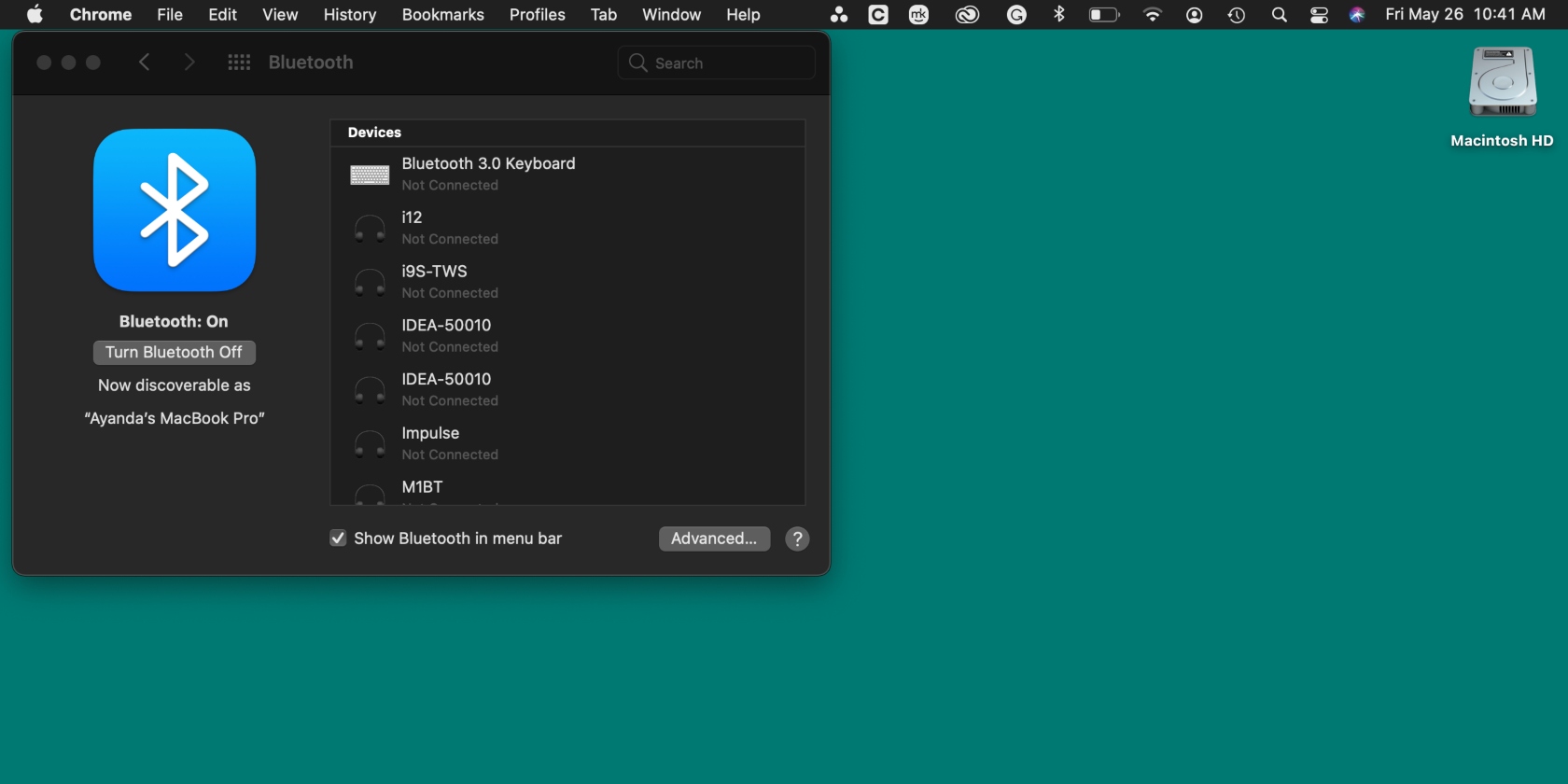
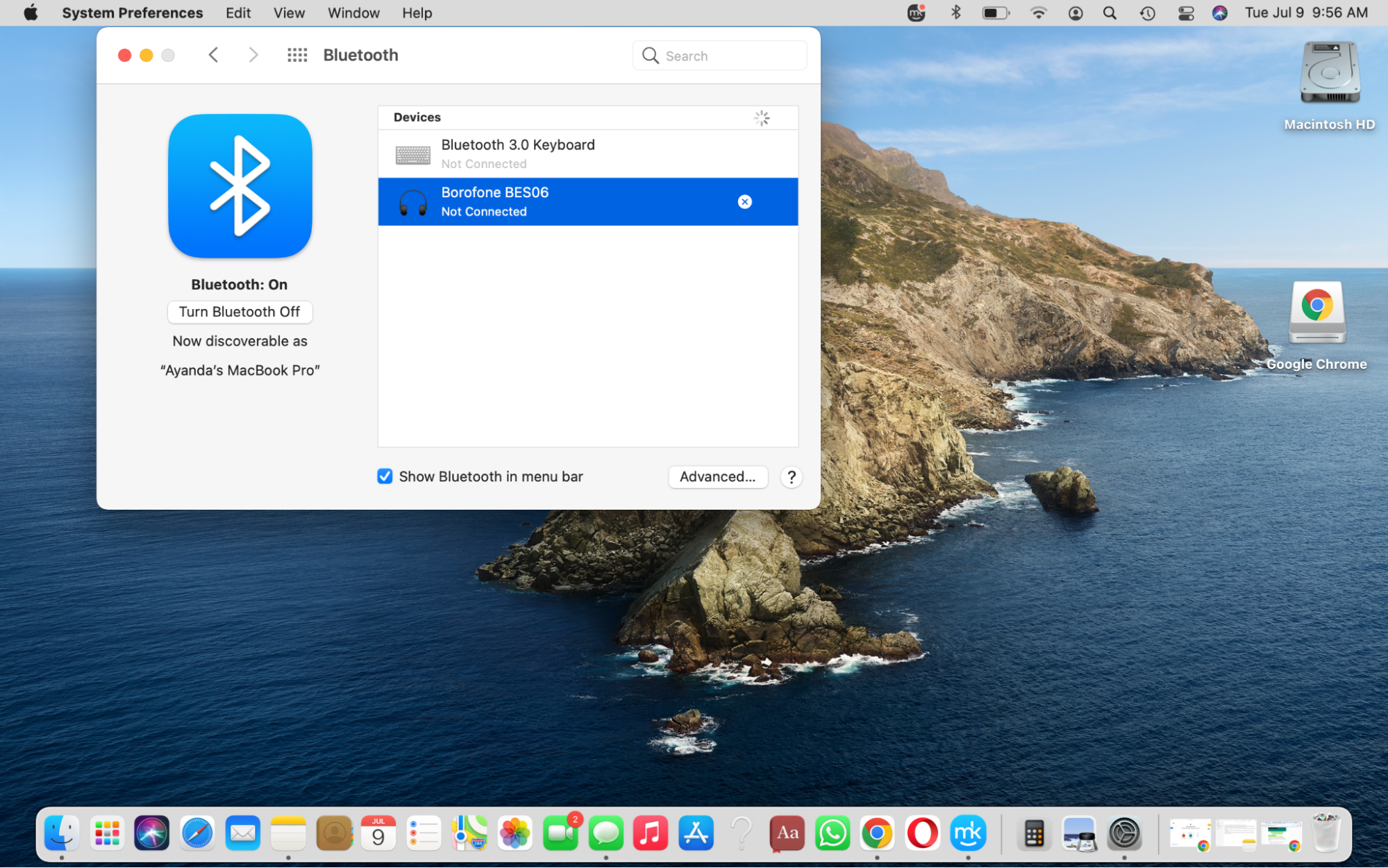
4. Check your sound preferences
The most obvious cause of your Mac’s sound not working could be found in sound settings. So, find out first if your Mac’s internal speakers are working.
In fact, this applies to all types of speakers, so try these steps to find out:
- Go to Apple Menu > System Preferences > Sound > Output.
- You should see Internal Speakers as a device for sound output. If you’re currently using another device, switch to Internal Speakers to use the built-in speakers and adjust the output volume. You might want to check if the Mute box is ticked. If it is, uncheck the box.
- If you don’t see the Internal Speakers option, try restarting your computer and resetting NVRAM. More on that later.
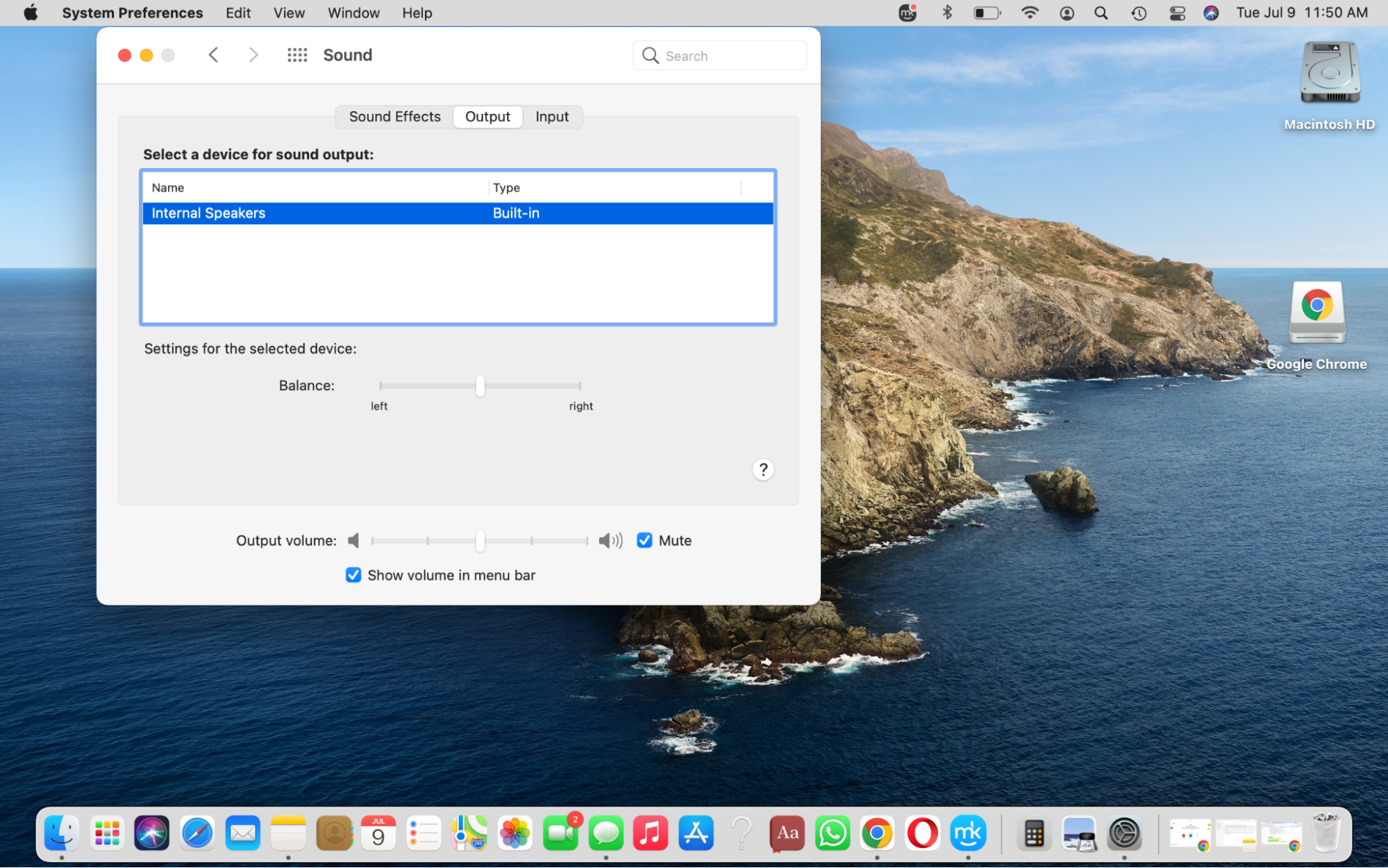
5. Restart your Mac
Restarting your Mac is one of the simplest and quickest ways to fix minor sound issues. That’s because it corrects any glitches in the system like distorted audio, resets the system and audio drivers, as well as frees up system resources and clears cache.
Follow these steps to restart your device:
- Click on the Apple menu and choose the Restart option.
- Check if your Mac’s sound has been fixed.
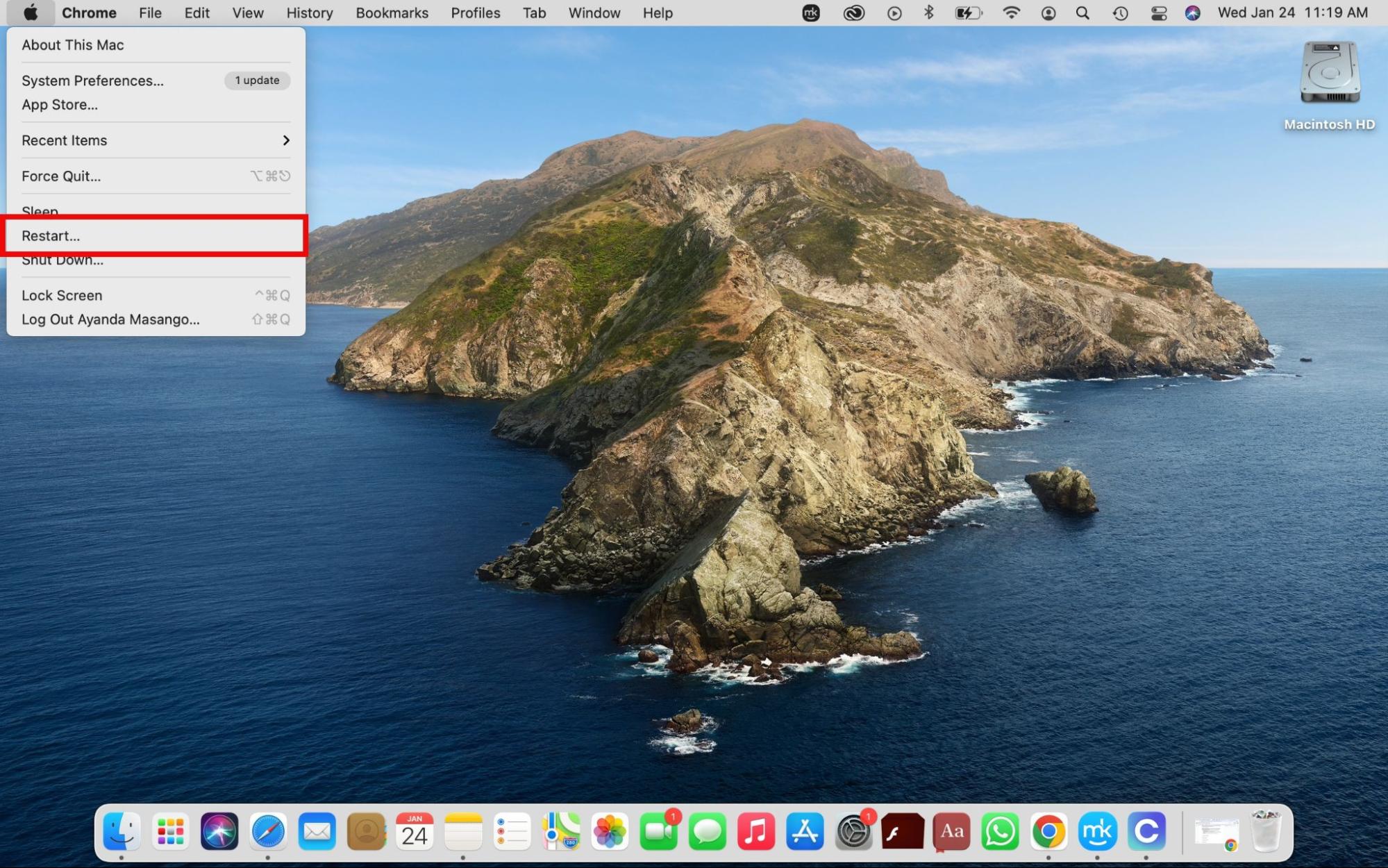
6. Restart the sound controller on your Mac
If you’re confident that the sound problem on your Mac doesn’t arise from a wonky cable, poorly established browser settings, or a misplaced output device, you might want to restart the sound controller. A faulty sound controller can affect your Mac’s volume or sound. Given that the Mac’s sound controller is responsible for your Mac’s sound, restarting it can help fix your sound issues. Here’s how to do it:
- Open Finder > Applications > Utilities > Activity Monitor > CPU.
- Look for the process named coreaudiod, select it, and hit the X icon at the top of the window to stop it and Quit to confirm.
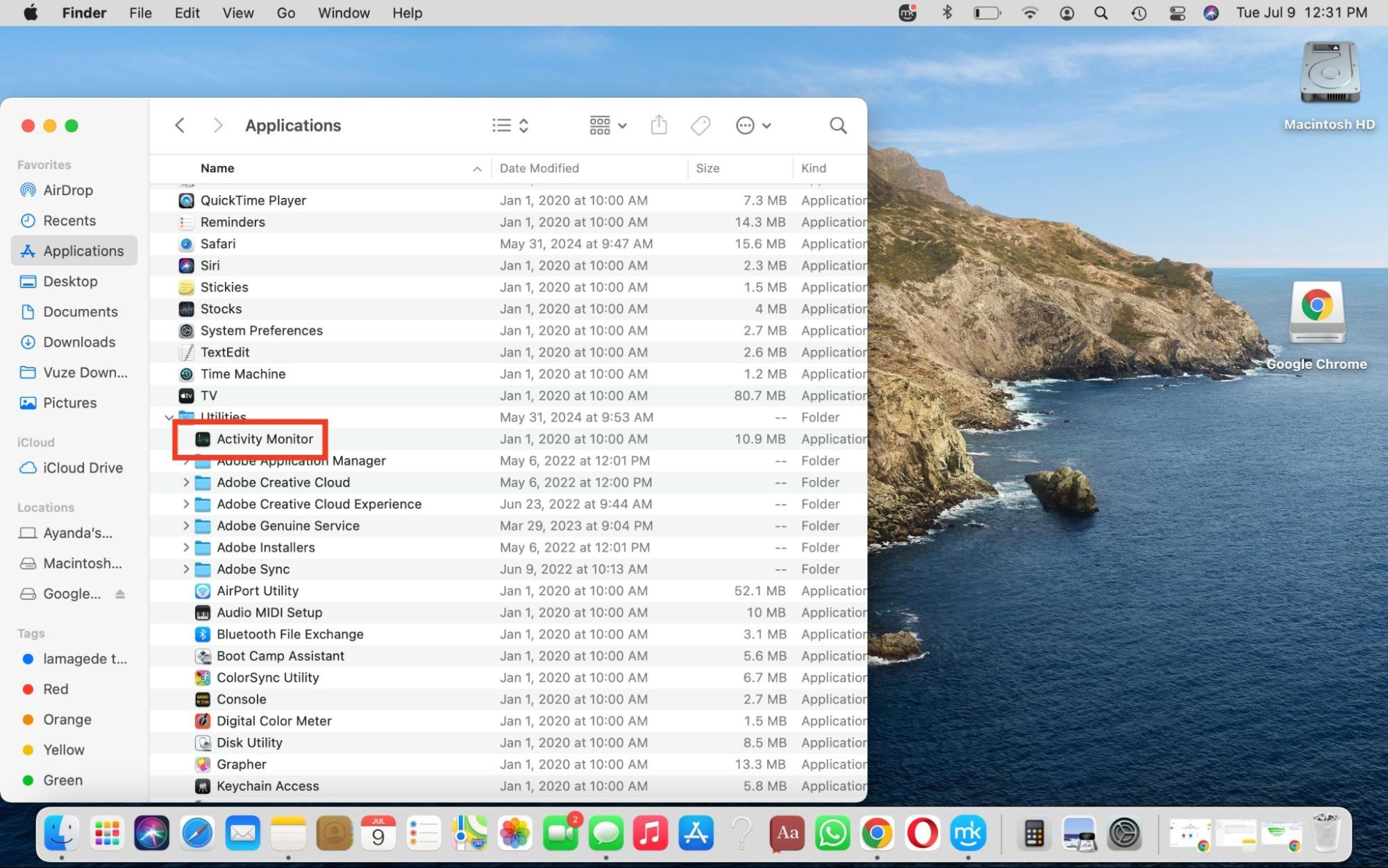
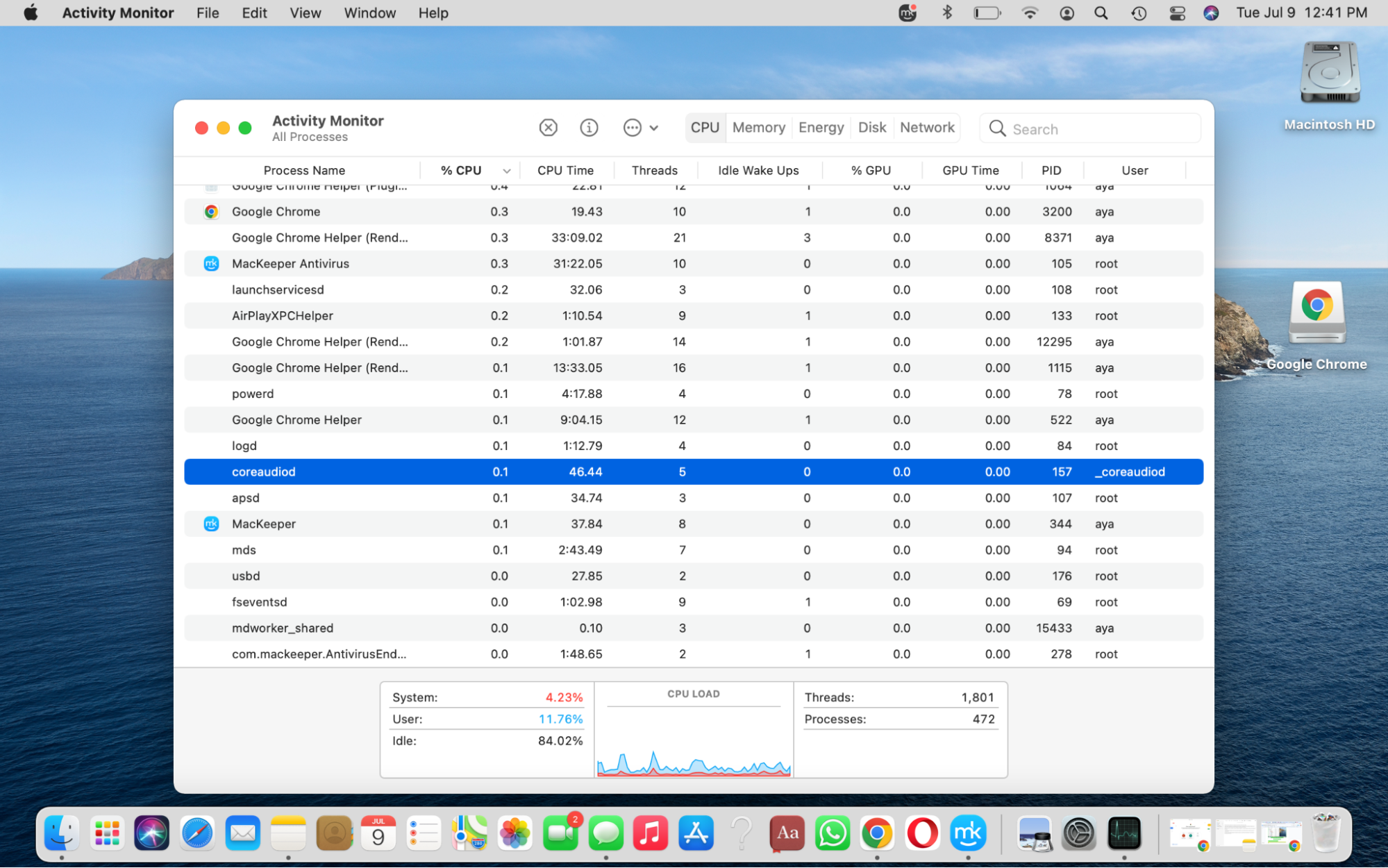
Important:
Want to learn more about this program? Here’s how to open and use Activity Monitor on your Mac.
7. Check hardware and other connections
Your external devices, like speakers and headphones, may be responsible for the lack of audio from your Mac. To find out if they’re guilty, disconnect and reconnect them individually, then restart your Mac and check if the sound is working.
8. Update macOS
First, keep your Mac’s operating system up-to-date for security reasons. However, consider that having an old OS version can result in all sorts of malfunctions, including sound problems.
You can check if you’re running the newest version of your operating system by doing the following:
- Go to the Apple menu in the top left corner of the screen and click System Preferences > Software Update.
- You’ll see the corresponding button if there is an update or an upgrade available.
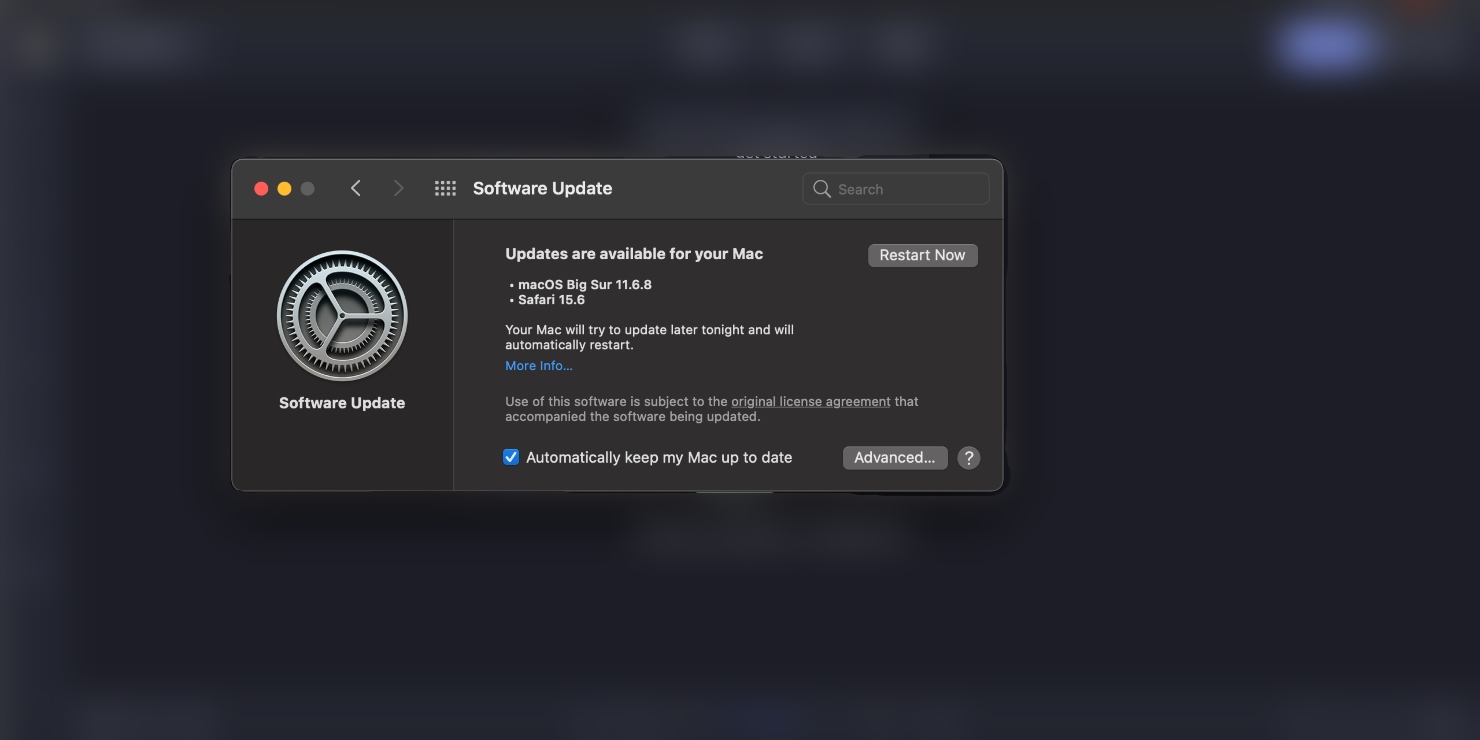
Note from our experts
Still not sure how to go about it? Here’s what to do:
- Learn how to update your Mac’s operating system to help you get started.
- Make sure your MacBook is backed up before you make any changes. You can use the Time Machine tool to do that.
9. Reset NVRAM and SMC
Non-volatile random access memory (NVRAM) stores important baseline settings on your Mac, like timezones and language. It also controls volume. Hence, NVRAM is the reason why the sound on your computer remains muted after you’ve shut it down and turned it back on. Resetting NVRAM, you’ll also resolve sound problems.
Here’s how to reboot NVRAM on an Intel Mac (note that you can’t reset NVRAM on Apple Silicon M1 and M2 devices):
- Shut down your Mac completely and disconnect USB devices and the charging cable.
- Press the power button to turn it back on. When you see the gray screen, hold Command + Option + P + R until the Mac reboots again and plays the startup sound.
- Reset any local settings, such as languages and time zones. Most importantly, the sound should now work fine.
Hint from our team: MacBooks released after 2018 are equipped with a T2 security chip that gives computers additional protection and allows them to have touch IDs. If you own one of these, look out for the Apple logo when resetting NVRAM—make sure it appears twice.
10. Check for malware infection
If nothing seems to resolve the problem and audio still doesn’t work on your MacBook, it’s either experiencing a hardware malfunction or is infected with a virus.
How do you tell if either of these is the case? Look out for signs such as:
- Excessive pop-up ads
- Suspicious warnings on the browser page
- Poor Mac performance
If any of these sound familiar, your laptop may be infiltrated with malware. If you’re still unsure, follow our guide to check for viruses or malware on your Mac. Here’s how:
- Launch MacKeeper and choose Antivirus > Enable > Start Scan.
- When the scan is finished, our app will notify you if it finds any threats. Follow the prompts to remove them from your device.
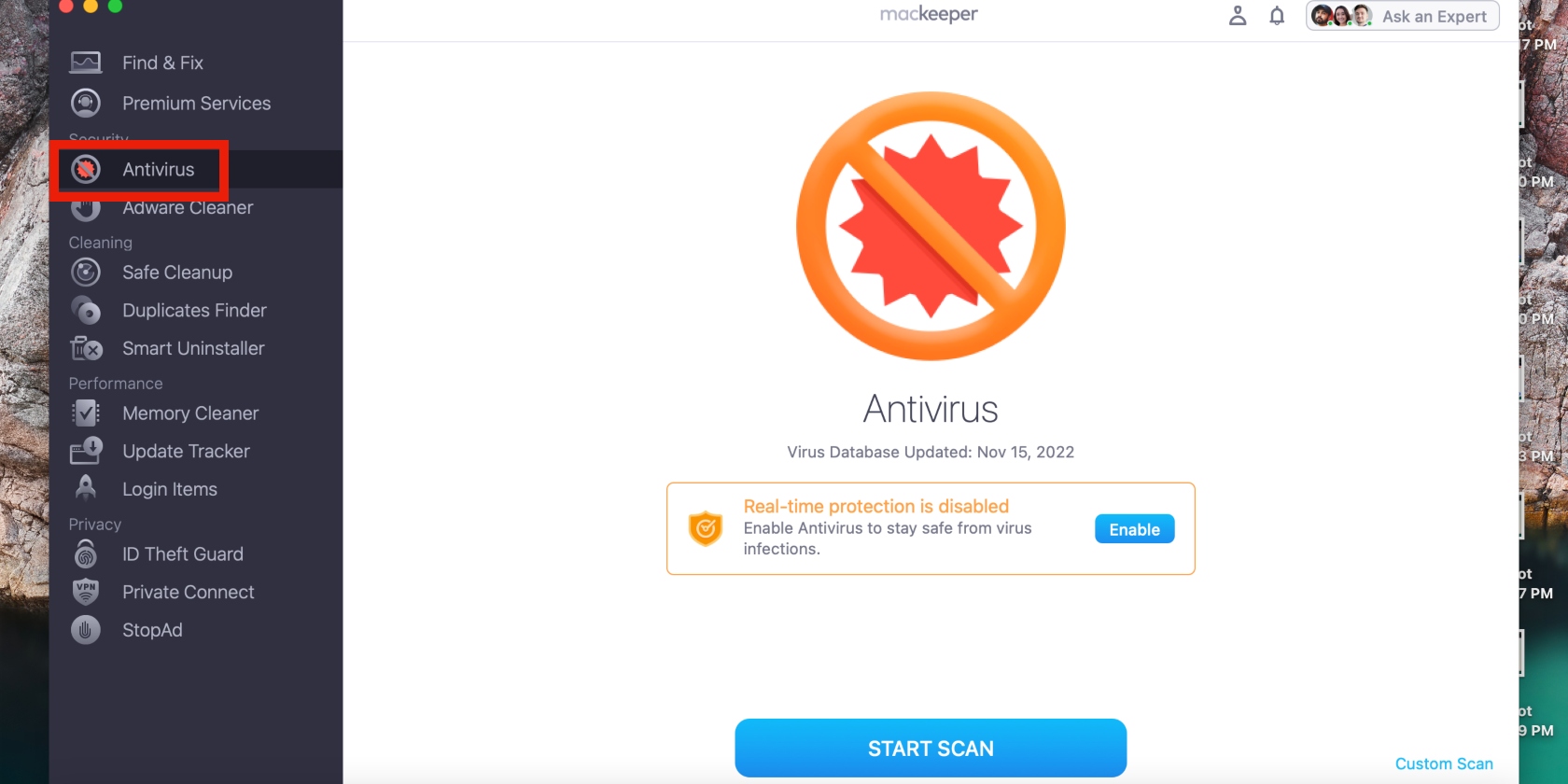
Our heads-up:
Simply deleting the source file isn’t enough—the virus will have spread across the entire system. It sticks to different files to make it harder to pin down and remove. Thus, you’d better use our Mac malware scanner to detect and exterminate it.
MacKeeper’s Antivirus tool emerges as one of the top solutions for completely ridding your Mac of viruses and malware. It’s safe, reliable, and protects your privacy by removing malicious threats. Besides, you can use it regardless of your level of cybersecurity or technology experience.
11. Fix audio on MacBook with Terminal
If you’ve used Terminal before, you’ll be familiar with the variety of functions it performs. It’s brilliant for fixing technical problems and has a solution for volume issues on your Mac.
Follow these simple steps to fix sound issues with Terminal:
- Go to Applications > Utilities > Terminal.
- Type in sudo killall coreaudiod and press Enter. This should reset your Core Audio daemon.
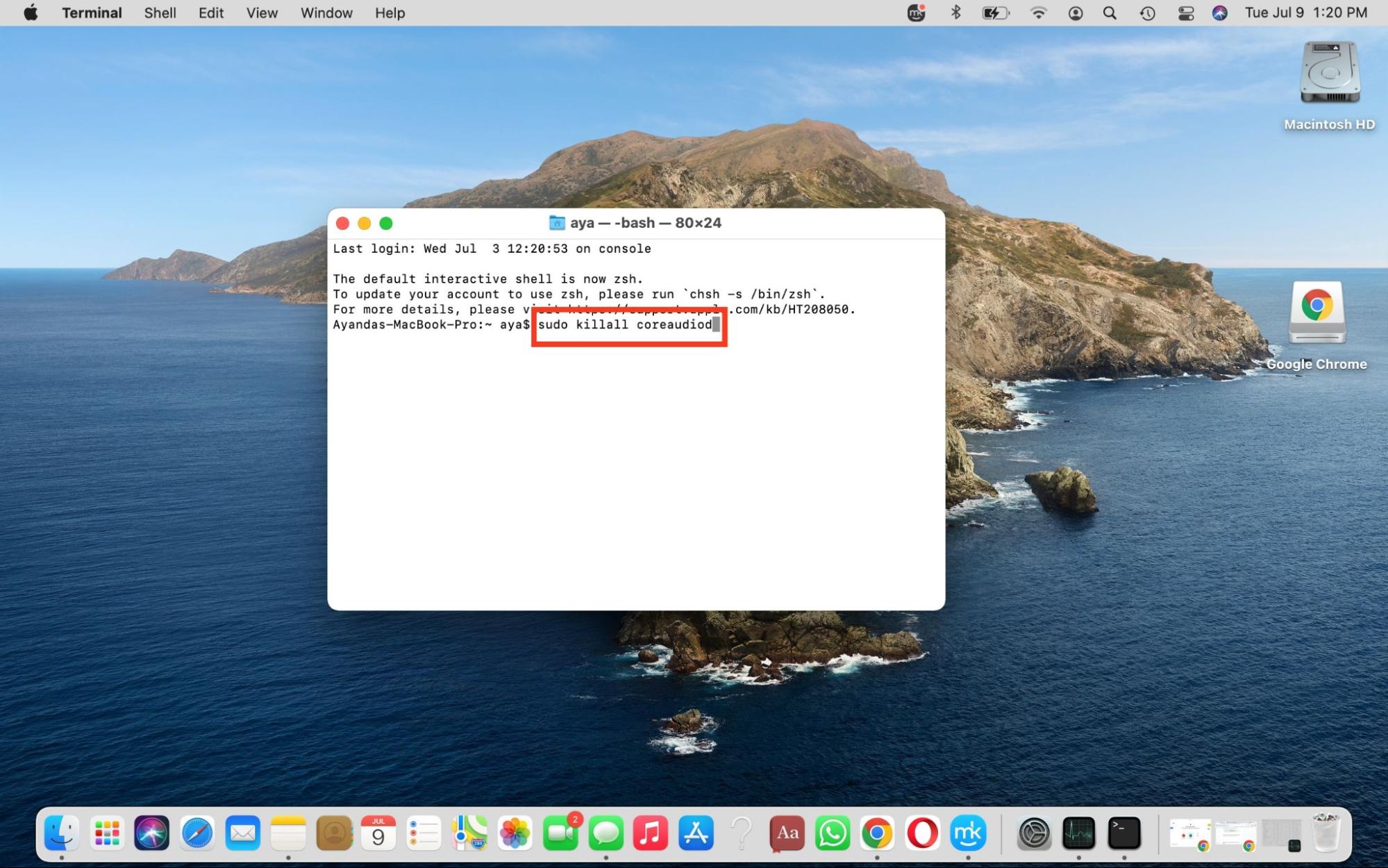
If you use Google Chrome, you might find that the newest versions interfere with the controller. To fix that, you first need to disable Chrome.
Here’s what you need to do to reset Core Audio as a Chrome user in Terminal:
- Start by shutting down Chrome. Type in sudo killall Google\ Chrome and press Enter. If this command doesn’t disable the browser, try pgrep -x Google Chrome.
- Terminal will now show you a number. Type in kill -9 _ with the number in place of the underscore. Hit Enter. This will knock out Chrome.
- You can now use the sudo killall coreaudiod command again to reset Core Audio. Google Chrome will work normally when you open it again.
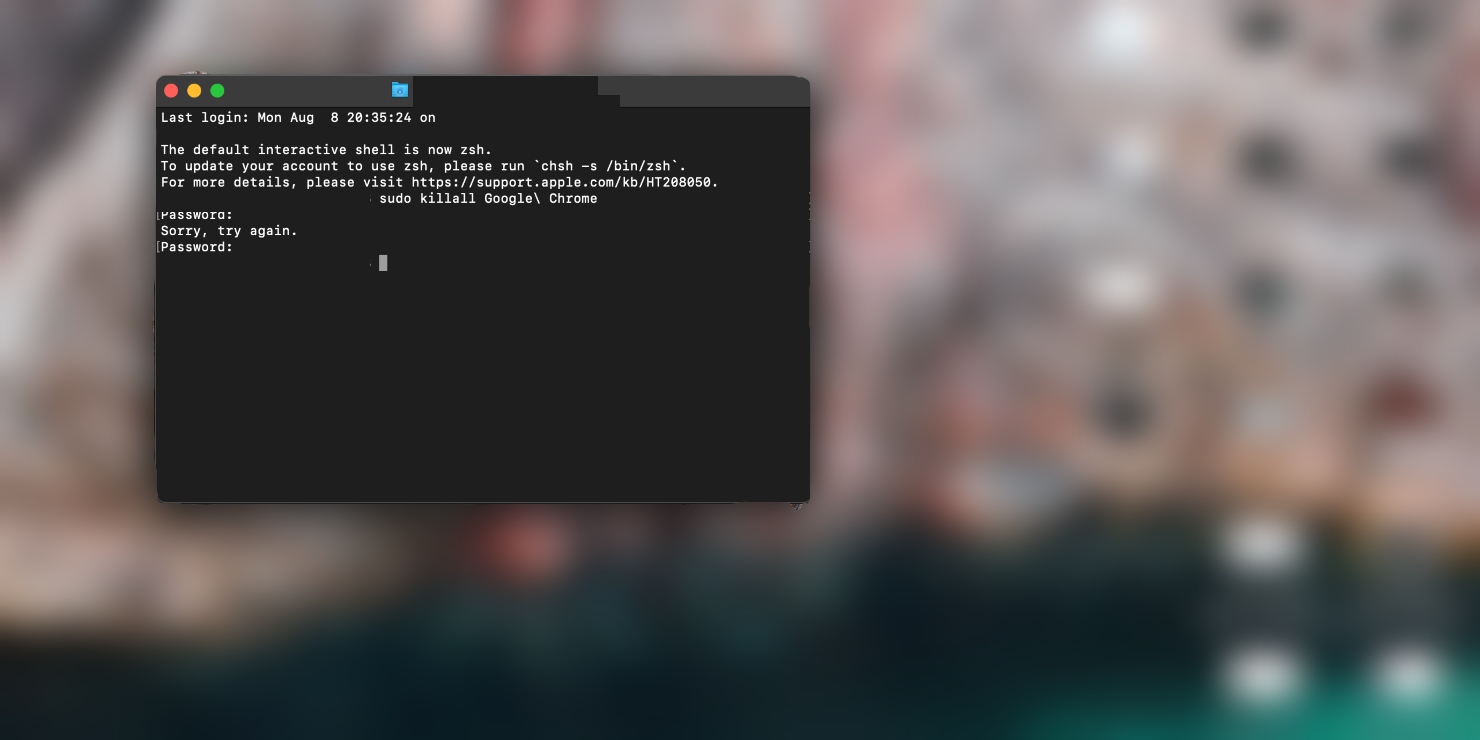
12. Check your sound settings in Audio MIDI Setup
Your Mac’s audio abilities aren’t limited to its speakers, headphone port, and microphone. macOS also processes audio from MIDI devices, such as musical keyboards and drum machines. Plus, it deals with virtual desktop audio, USB audio, Bluetooth audio, and more.
You can check all of these devices with the Audio MIDI Setup tool.
- Go to Applications > Utilities, and open Audio MIDI Setup. You can now see which devices are currently selected for output, input, and system sounds. Look for the small icons next to them.
- Find the audio device you want to hear sound from, right-click it, and select Use This Device For Sound Output.
- If there’s still no sound, click Output, and try the volume sliders under Channel Volume.
- Make sure none of the channels are muted. If any are ticked, untick them.
- If that doesn’t work, use the dropdown menu next to Format, and try the different options.
- You can also test your audio device by clicking the Configure Speakers button.
- In the Test section, click the speaker icon, and you should hear a hissing sound (a test tone). If you hear it, then your speaker is working, and your problem is likely caused by something else.
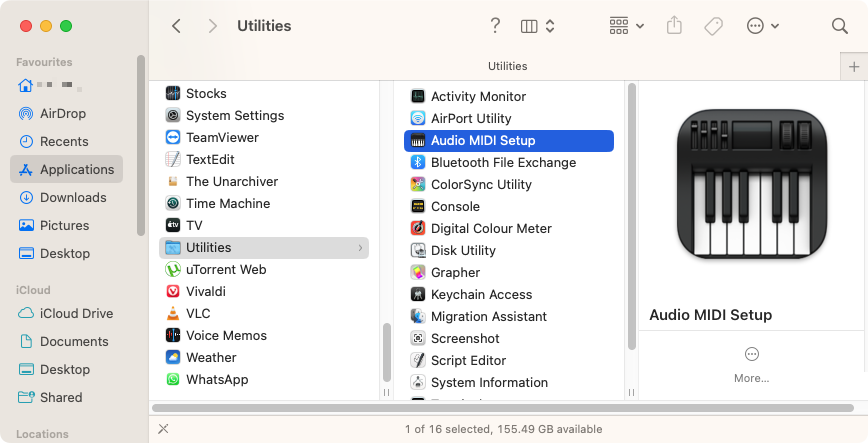
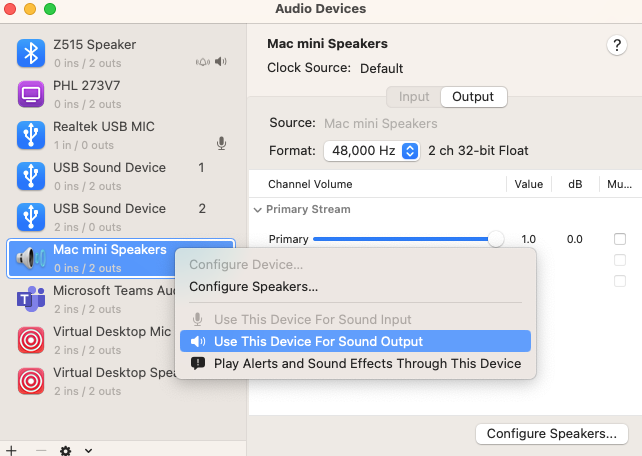
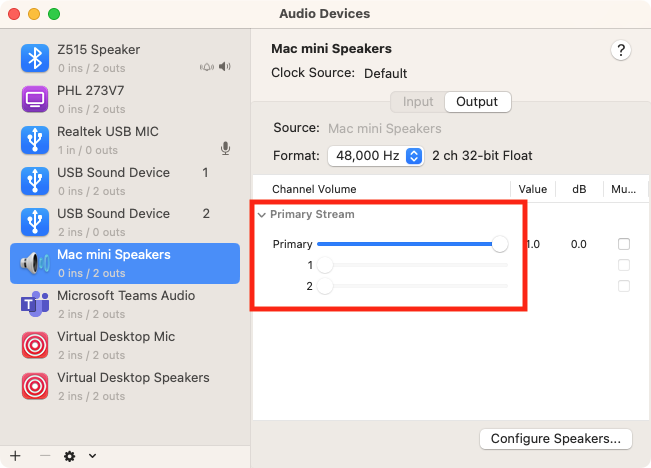
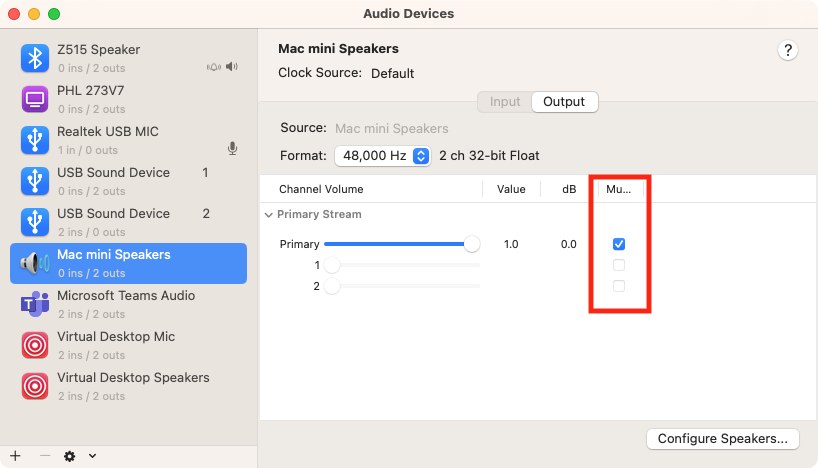
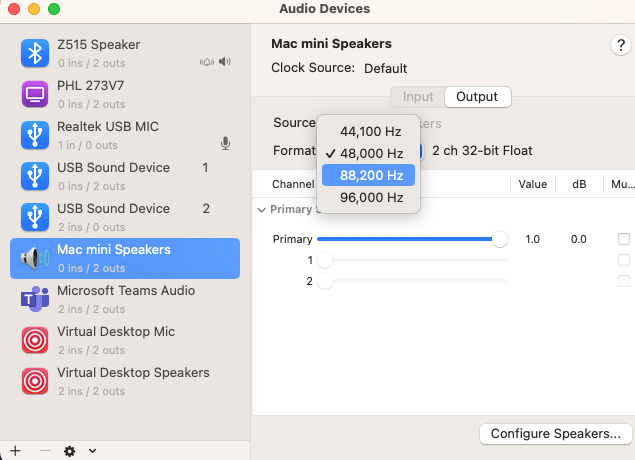
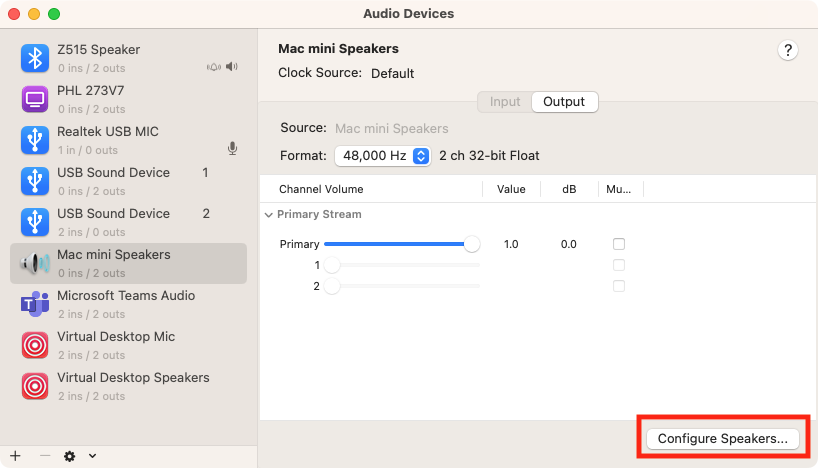
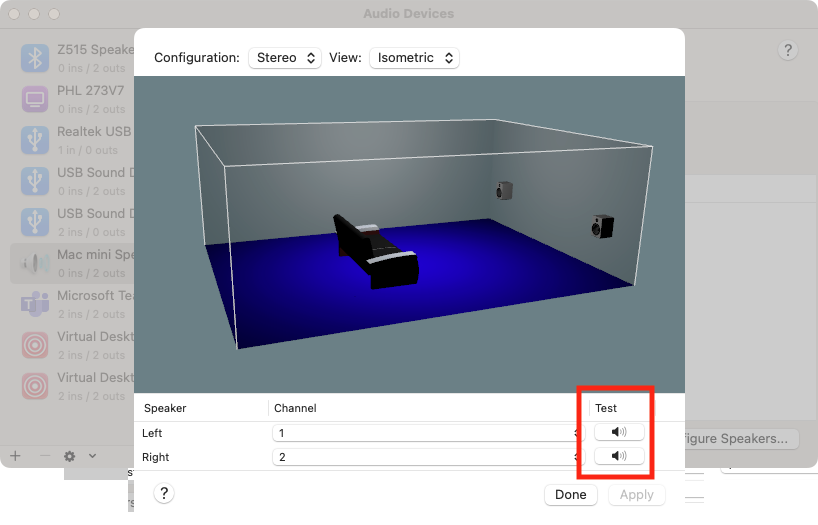
How to fix sound not working on external Mac devices
Have you tried playing a song in a different app? Try various websites and audio files. If your MacBook Pro or iMac still has no sound, go through the other fixes below.
Troubleshooting for external speakers
Does it seem like your Mac’s external speakers aren’t working? If you’re using external speakers, the first thing you should check is whether the device is properly connected to your computer. The cable must be tightly attached to the USB or audio jack, and the port itself has to be clean.
We tend to collect dust in them over time, so make sure to regularly clean it with cotton buds, toothpicks, and compressed air to enable proper connection.
If you don’t think that the cable is the source of the issue, follow the steps below:
- Go to Apple Menu > System Preferences > Sound > Output and make sure to choose your external USB speakers as the output device.
- If you don’t see them there, try unplugging and plugging them back in.
- If they’re connected via the audio port, you’ll see a pop-up menu called Use audio port for… Check that it’s set for Sound Output.
Of course, if you aren’t using external speakers, this isn’t something you should worry about.
Troubleshooting for display audio
Before going to System Preferences, make sure that the display’s cable is properly connected to your laptop’s ports and that there are no headphones plugged into the audio port.
Once that’s done, go to System Preferences > Sound and set the settings in the Output section for Display audio as the output device.
Troubleshooting for digital receiver
To fix the sound for digital receivers, check that you’re using the right connector—you need a special optical digital cable. Next, check the receiver's settings (you’ll find the instructions on how to do that in your device’s manual)—they have to be set up for digital input.
Then, follow the instructions below:
- On your Mac, go to System Preferences > Sound > Output and select Digital Output as the device.
- Play with the volume controls on the receiver to see if you’d accidentally left it off.
Sound issues sorted
Hopefully, after reading our guide, you’ve figured out what may be the cause of your sound problems. However, if you’re still having issues, it’d be best to contact MacKeeper’s Premium Services. Located in the MacKeeper app, this option connects you to a professional who can troubleshoot and resolve your Mac’s sound, saving you valuable time and effort. Try it out today for your quick troubleshooting!







